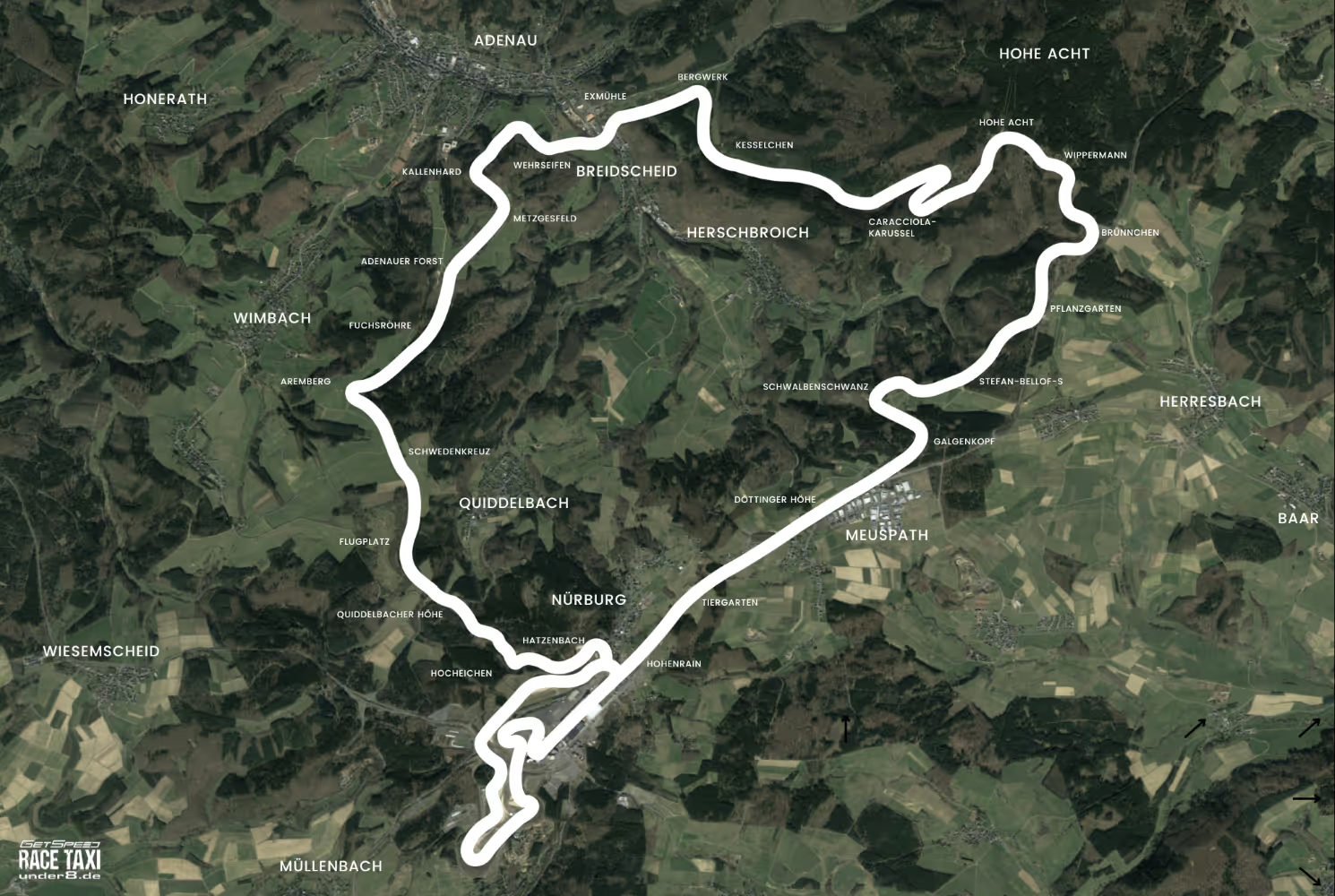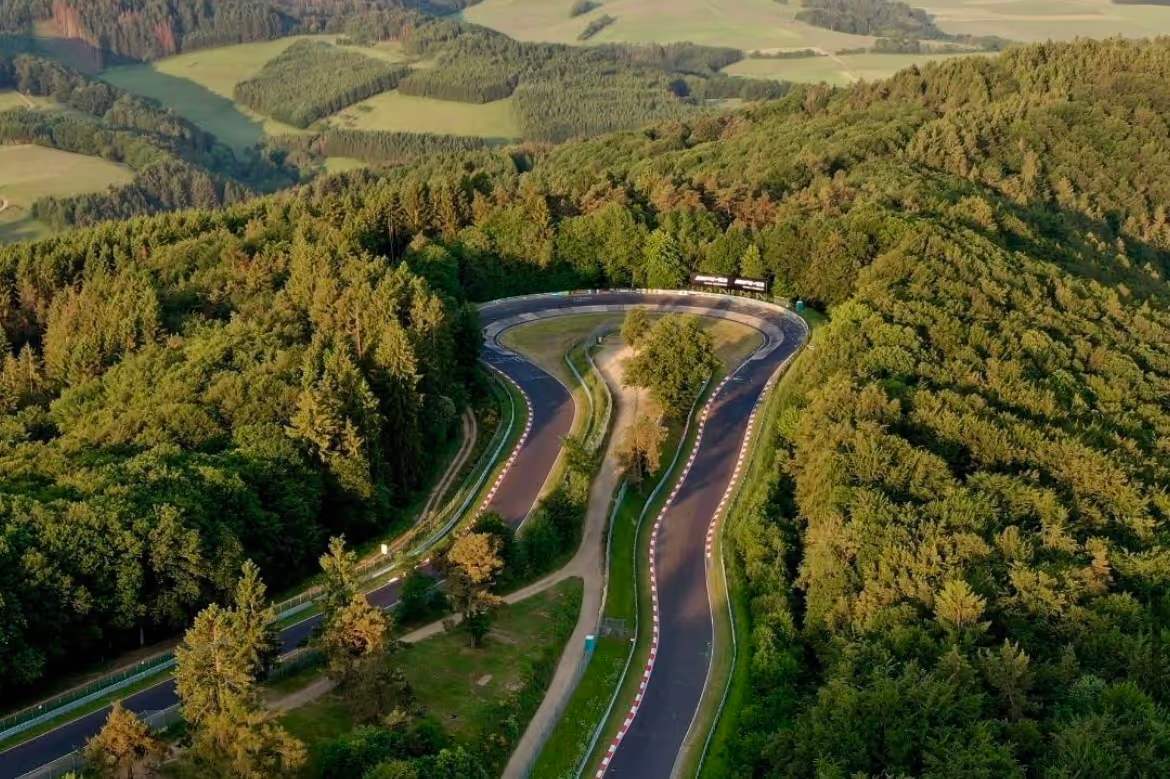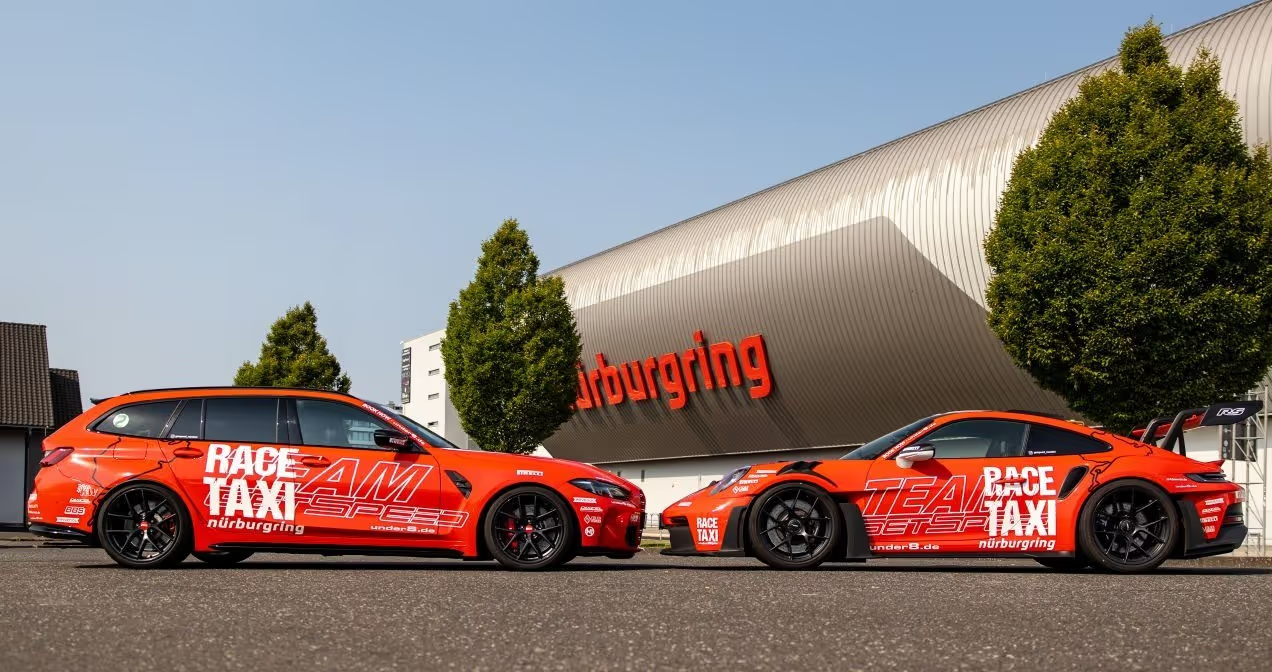
History
The most famous corners on the Nürburgring — and their stories
The Nürburgring — it's not just a race track. He is a legend. Kilometer after kilometer full of drama, myth and very special corners. Many corners have their own names — and each tells its own story.
Nürburgring: Where legends are born — and heroes fail
Deep in the forests of the Eifel lies a place where motorsport dreams come true — or end forever.
The Nürburgring is more than just a race track: it is a test, a myth, a legend.
Since 1927, the Nordschleife has demanded everything from those who face it: courage, skill and respect. Here, every mistake is punished and heroes are born.
Join us on a journey to the most famous corners and unforgettable moments of this unique “Green Hell”.

Karussell — The banked corner of legends
If you know the Nürburgring, you also know the carousel. This concrete banked corner has cult status. It owes its name to racing driver Rudolf Caracciola, who in the 1930s used the then still bumpy concrete gutter as an abbreviation — a risky but clever manoeuvre that soon found imitators. Today, even modern GT3 cars are rumbling around here, and it is always a spectacle.
Bergwerk — The tricky trap
There is hardly any other place where the Nürburgring has earned more respect than here. The Bergwerk ("mine") corner has its gloomy fame not only due to the serious accident involving Niki Lauda in 1976. The tight right turn after a quick passage surprises many who are too optimistic about the gas. The name? A reminder of the time when mining really took place here.
Flugplatz — The moment of takeoff
“Flugplatz” ("airfiled") sounds dramatic — and it is. Originally named after a small airfield from the 1920s, today an inconspicuous bump causes the cars to take off easily. If you don't land clean here, you'll quickly find yourself off the track. A classic for spectacular photos and nervous heartbeats.
Fuchsröhre — Full throttle and nerves of steel
The Fuchsröhre ("foxhole") is not for the timid. A steep slope and brutal speed require full concentration. The name comes from the foxes that once roamed underground pipes here. Today, racing cars are more likely to roam here — at a pace that barely forgives mistakes.
Adenauer Forst — The stumbling block
Many have already miscalculated here: The abrupt line change often forces even experienced drivers to make late corrections. The Adenauer Forst ("adenauer forest") is particularly popular with tourists, causing quite a few spins and unwanted shortcuts – much to the amusement of spectators lining the track.
Brünnchen — Where the fans are waiting
The party's in full swing at Brünnchen. The fans are standing close together here with barbecues, beers and good spirits. The name comes from a small fountain nearby, but today it's less about water and more about action. Whoever flies off into the gravel here can be sure: The spectators will celebrate it with applause and roar.
Schwalbenschwanz — The final straight is coming closer
Just before the end, the Schwalbenschwanz ("swalllowtail") waits — a quick passage with a tight chicane. The name goes back to the street shape, which reminds people of a swallowtail. This is followed by the “Little Carousel” — a miniature copy of the big brother, but no less tricky.

Nürburgring: The legend of the Green Hell
When you think of legendary racetracks, one name comes to mind: Nürburgring.
The “Green Hell,” as Jackie Stewart once called him, is much more than asphalt and barriers. It is a myth, a challenge — and a home for all those who have speed in their blood.
The dream of owning a ring — How it all began
Motorsport boomed in the early 1920s — but Germany lacked a permanent racetrack. Racing on public roads was dangerous and unpredictable.
The answer? An ambitious project in the middle of the wild Eifel.
In 1927, the Nürburgring was opened: A huge 28.265 kilometers long track, divided into Nordschleife and Südschleife. It was already clear on the opening weekend: this is where the wheat is separated from the chaff.
Nordschleife — The heart of the legend
The Nordschleife in particular has become an icon. 20.832 kilometers, 73 corners, up to 300 meters difference in elevation — a challenge that pushes even experienced racing drivers to their limits. Blind crests, brutal chicanes, changeable weather — every round is a razor blade ride.
Jackie Stewart gave the track the name, which still gives you goosebumps today: “Green Hell”.
The change — From the Südschleife to the modern Grand Prix track
While the Nordschleife consolidated its legendary reputation, the Südschleife lost importance.
In the 1970s, the Nürburgring was considered too dangerous for modern Formula One — especially after Niki Lauda's serious fire accident in 1976. The answer was the construction of a new, safe facility: the Grand Prix track was opened in 1984.
Shorter, clearer, more modern — but the spirit of the Nürburgring remained unwavering. And the Nordschleife stayed — as the ultimate test for drivers and machines.

Moments for eternity
- Jackie Stewart's “Green Hell” (1968)
With a broken wrist and in torrential rain, Stewart won — and created a synonym for the Nürburgring, which still exists today. - Niki Lauda's fire accident (1976)
A drama that shook the motorsport world — and marked the beginning of one of the greatest comeback stories of all time. - Stefan Bellof's record lap (1983)
6:11.13 minutes — a magical time that remained unmatched for decades. - Timo Bernhard's record lap (2018)
Bernhard shattered all records with the Porsche 919 Hybrid Evo: 5:19.55 minutes — a lap that is still considered incredibly fast today.
The Nürburgring today — a legend that lives
Today, the Nürburgring is more than just a race track. It is a place of pilgrimage for motorsport fans, a testing ground for manufacturers, an adventure playground for tourist drivers.
Anyone who has ever been on the Nordschleife knows that it's not just about speed. This is about heart.
And this myth will continue to fascinate for many generations to come.


